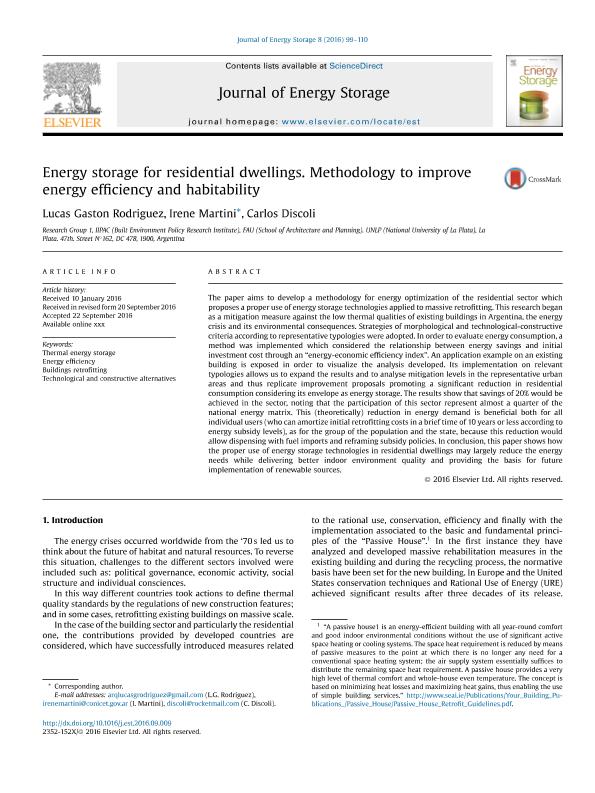Mostrar el registro sencillo del ítem
dc.contributor.author
Rodríguez, Lucas Gastón

dc.contributor.author
Martini, Irene

dc.contributor.author
Discoli, Carlos Alberto

dc.date.available
2018-08-09T19:42:53Z
dc.date.issued
2016-11
dc.identifier.citation
Rodríguez, Lucas Gastón; Martini, Irene; Discoli, Carlos Alberto; Energy storage for residential dwellings. Methodology to improve energy efficiency and habitability; Elsevier; Journal of Energy Storage; 8; 11-2016; 99-110
dc.identifier.issn
2352-152X
dc.identifier.uri
http://hdl.handle.net/11336/54847
dc.description.abstract
The paper aims to develop a methodology for energy optimization of the residential sector which proposes a proper use of energy storage technologies applied to massive retrofitting. This research began as a mitigation measure against the low thermal qualities of existing buildings in Argentina, the energy crisis and its environmental consequences. Strategies of morphological and technological-constructive criteria according to representative typologies were adopted. In order to evaluate energy consumption, a method was implemented which considered the relationship between energy savings and initial investment cost through an “energy-economic efficiency index”. An application example on an existing building is exposed in order to visualize the analysis developed. Its implementation on relevant typologies allows us to expand the results and to analyse mitigation levels in the representative urban areas and thus replicate improvement proposals promoting a significant reduction in residential consumption considering its envelope as energy storage. The results show that savings of 20% would be achieved in the sector, noting that the participation of this sector represent almost a quarter of the national energy matrix. This (theoretically) reduction in energy demand is beneficial both for all individual users (who can amortize initial retrofitting costs in a brief time of 10 years or less according to energy subsidy levels), as for the group of the population and the state, because this reduction would allow dispensing with fuel imports and reframing subsidy policies. In conclusion, this paper shows how the proper use of energy storage technologies in residential dwellings may largely reduce the energy needs while delivering better indoor environment quality and providing the basis for future implementation of renewable sources.
dc.format
application/pdf
dc.language.iso
eng
dc.publisher
Elsevier

dc.rights
info:eu-repo/semantics/openAccess
dc.rights.uri
https://creativecommons.org/licenses/by-nc-sa/2.5/ar/
dc.subject
Buildings Retrofitting
dc.subject
Energy Efficiency
dc.subject
Technological And Constructive Alternatives
dc.subject
Thermal Energy Storage
dc.subject.classification
Historia

dc.subject.classification
Historia y Arqueología

dc.subject.classification
HUMANIDADES

dc.title
Energy storage for residential dwellings. Methodology to improve energy efficiency and habitability
dc.type
info:eu-repo/semantics/article
dc.type
info:ar-repo/semantics/artículo
dc.type
info:eu-repo/semantics/publishedVersion
dc.date.updated
2018-08-09T15:34:49Z
dc.journal.volume
8
dc.journal.pagination
99-110
dc.journal.pais
Reino Unido

dc.journal.ciudad
Londres
dc.description.fil
Fil: Rodríguez, Lucas Gastón. Consejo Nacional de Investigaciones Científicas y Técnicas; Argentina. Universidad Nacional de la Plata. Facultad de Arquitectura y Urbanismo. Instituto de Investigaciones y Politicas del Ambiente Construido; Argentina
dc.description.fil
Fil: Martini, Irene. Consejo Nacional de Investigaciones Científicas y Técnicas; Argentina. Universidad Nacional de la Plata. Facultad de Arquitectura y Urbanismo. Instituto de Investigaciones y Politicas del Ambiente Construido; Argentina
dc.description.fil
Fil: Discoli, Carlos Alberto. Consejo Nacional de Investigaciones Científicas y Técnicas; Argentina. Universidad Nacional de la Plata. Facultad de Arquitectura y Urbanismo. Instituto de Investigaciones y Politicas del Ambiente Construido; Argentina
dc.journal.title
Journal of Energy Storage
dc.relation.alternativeid
info:eu-repo/semantics/altIdentifier/doi/https://dx.doi.org/10.1016/j.est.2016.09.009
dc.relation.alternativeid
info:eu-repo/semantics/altIdentifier/url/https://www.sciencedirect.com/science/article/pii/S2352152X16301657
Archivos asociados
